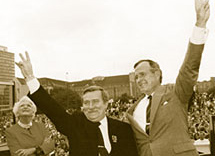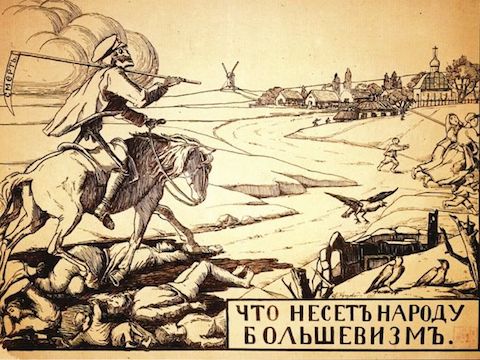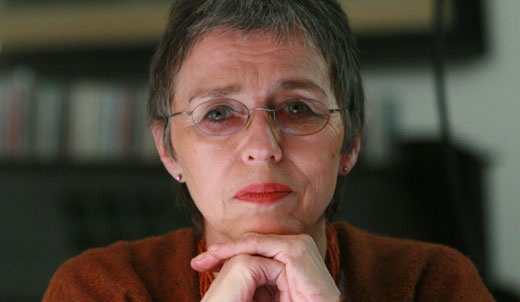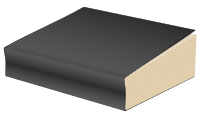Political Map of the Soviet Union

Topics on the Page
Weaknesses of the Soviet Command Economy
Lech Walesa and the Solidarity Movement
Ronald Reagan's Anticommunist Policies
Resistance to Communism in the Soviet Union and in Europe
- Mikhail Gorbachev
- Boris Yelstin
- Malgorzata Bochenska, Polish filmmaker and democracy activist
 Cross-Links
Cross-Links
Focus Question: What factors contributed to the decline and collapse of the Soviet Union?
The Weaknesses of the Soviet Command Economy
- One problem that the Soviet Union faced in maintaining its power was its economic transition.
- It had once been in a command economy, but the country found it harder and harder to keep it up.
- an economic system where the state directs the economy
- It was under the weight of this burden that Mikhail Gorbachev (photo below) decided to allow a limited capitalism.
- Glasnost, meaning "openness" had allowed people to speak out more freely about their concerns with the Soviet government
- An opportunity for criticism that had long been absent from the Russian political scene.
- Books were no longer banned
- political prisoners were released
- newspapers could print government criticism
- Political parties could participate in elections, not just Communists
- This prompted Gorbachev to undertake perestroika
- an economic restructuring project, allowing more capitalism.
- Companies could be privately owned for the first time in decades
- Workers could strike for better wages and conditions
- Foreign countries could invest in Soviet companies
- This lack of control was problematic due to the great unrest that existed within many parts of the Soviet Union.
- Due to the oppression of Gorbachev's predecessors, many people, when finally given the chance to raise their voices,
- began to question their part of a regime they did not agree with.
- This would lead to many revolutions across Eastern Europe.
 Seventeen Moments in Soviet History, 1917-1991 is an online archive of texts, images, maps and video materials on the Soviet Union, including Khrushchev's Secret Speech.
Seventeen Moments in Soviet History, 1917-1991 is an online archive of texts, images, maps and video materials on the Soviet Union, including Khrushchev's Secret Speech.
The Revolutions of 1989
The anti-communist revolutions of 1989 were a series of non-violent protests and uprisings that took place in several Eastern European countries. These revolutions were aimed at overthrowing the communist governments that had been in power for decades and establishing democratic societies.
The first of these revolutions took place in Poland in 1989, where the Solidarity movement, led by Lech Walesa, was able to negotiate a peaceful transition to democracy. This was followed by similar movements in other countries, such as Hungary, East Germany, Czechoslovakia, Romania, and Bulgaria.
The protests and uprisings varied in intensity and duration, but they all shared a common goal: to end communist rule and establish democratic governments. Many of the protests were peaceful and involved large numbers of people demonstrating in the streets, but there were also some violent clashes between protesters and police forces.
The Revolutions of 1989, Office of the Historian, U.S. Department of State
The Revolutions of 1989 would lead to the decline and collapse of the communist regimes of Eastern Europe, with the Soviet Union falling soon after.
Making the History of 1989: The Fall of Communism in Eastern Europe, a website with primary sources and teaching modules from the German Historical Association, the National Endowment for the Humanities and the Center for History and New Media at George Mason University.
Lech Walesa, President George Herbert Walker Bush and First Lady Barbara Bush, 1989

Lech Walesa and the Solidarity Movement in Poland
Lech Walesa's Solidarity movement was a Polish trade union and social movement that emerged in the late 1970s and early 1980s.
It was initially formed as an independent workers' union in response to the economic and political conditions in Poland at the time, which were characterized by shortages of basic goods, high unemployment, and political repression.
Solidarity remained an important force in Polish society throughout the 1980s, and played a key role in the collapse of communism in Poland and the rest of Eastern Europe in 1989.
In 1990, Walesa was elected as the first non-communist president of Poland, and he continued to be an important political figure in the country for many years.

- Lech Walesa was a Polish labor activist
- He worked as an electrician
- Witnessed the food riots, in which police killed demonstrators
- Became a union activist in 1976, but lost his job
- In 1980, he joined a worker strike in the shipyards
- Elected to strike committee to negotiate
- Strike demands meet 3 days later
- Other workers still on strike, so Walesa created a solidarity strike
- Proclaimed as a general strike, the workers demanded the right to strike and form free trade unions
- About 10 million Polish workers joined the solidarity strike, which became a confederation of unions
- In 1981, Poland outlawed solidarity and Walesa was detained for about 1 year.
- In 1988, solidarity was legal once again
Walesa won a Nobel Peace Prize in 1983. He was unable to attend the ceremony, but his wife read this speech on his behalf.
 Go here for a biography of Lech Walesea from the Noble Prize committee. Click here for his Britannica entry
Go here for a biography of Lech Walesea from the Noble Prize committee. Click here for his Britannica entry
The Anticommunist Policies of President Reagan
- One of the main focuses of Ronald Reagan's presidency (1981-1989) was to stop Communism from spreading
- He saw Communism as a great evil that had to be stopped at all costs
- referred to the Soviet Union as "an evil empire"
- Combination of Reagan's policy and the Soviet Union's softening of their policies to allow freer speech and limited introduction of capitalism helped work towards the ending of the Cold War.
The Reagan Doctrine
- Announced in Reagan's 1985 State of the Union Address
- Pledged to support anticommunist revolutions
- Afghanistan
- United States provided aid to anti-Soviet fighters
- Helped force the withdrawal of the Soviets
- Nicaragua
- 1979: Nicaragua's corrupt government was overthrown
- Young Marxists, known as Sandinistas, took over
- Claimed to be free and support a mixed economy
- Really cancelled elections, forced people who opposed them into exile, and looked to the Soviets for leadership
- Reagan thought Nicaragua would become another Cuba
- Reagan supported training of anti-Sandinistas rebels
- The rebels worked against the government with assistance from the CIA
- In 1990, national elections in Nicaragua overthrew the Sandinistas
- Reagan was able to receive donations from individuals and other countries who wanted to win the support of the USA.
- Reagan also sold arms to Iran through the CIA and the profits went towards the stop of communism (Iran-Contra Affair)
- In 1986, a Congressional investigation on the arms sales to Iran began (Click here for a timeline regard the Iran-Contra Affair)
Click here for more on the Reagan Doctrine
The Berlin Wall, 1986

Click here for a YouTube video on the Berlin Wall's removal in 1989.
Photographic slide show of The Rise and Fall of the Berlin Wall.
Click here for Reagan-Gorbachev relations from History.
Click here for a brief video from the documentary series the Cold War detailing the Reykjavik Summit.
 Primary Sources
Primary Sources
Ronald Reagan's 1987 famous "Tear down this wall" speech at the Bradenburg Gate in Berlin. Time magazine article crediting Reagan's speech as "the speech that brought down the wall."
Click here for a collection of Reagan's State of the Union addresses
Click here for the Iran-Contra findings from the Congressional investigation
The Resistance to Communism in the Soviet Union and Eastern Europe
- Many of the new revolutions in Eastern Europe would reject Communism altogether
- felt it had failed them as members of the Soviet Union.
- Lech Walesa's movement was a strong labor movement, but not one of Communism.
- Vaclav Havel, a playwright and gadfly of the former administration, also rejected Communism as the answer for Czechslovakia.
- These revolutions, and those like it, generally rejected Communism
- further led to the dissipation of not only the Soviet Union, but many of the principles that had held it together.

Click here for images like the one above that show some of the Anti-Communist sentiments from the time in Europe and the rest of the world
Click here for an article by the Lithuanian parliament about it regaining its independence in 1990.
Click here for an article about the national identities of ethnic minorities in the USSR.
Gorbachev and Yeltsin
Gorbachev and Ronald Regan, November 1985

 Boris Yeltsin
Boris Yeltsin
Mikhail Gorbachev had a difficult time leading the Soviet Union
- He wanted to have a free market economy and believed communist practices should be democratized
- He also wanted to improve relations with the Western world, especially the United States
- His policies were criticized heavily in the Soviet Union
- Many people felt he was making the Soviet Union a second-class country
In August 1991 the military and communist government planned a coup against Gorbachev
- He was put under house arrest and pressured to resign as President
- Gorbachev refused
- His supporters in Parliament called for the people of the Soviet Union to oppose the coup
- Thousands took to the streets in support of Gorbachev
- The coup failed a few days later
Despite the failure of the coup, Gorbachev lacked support from the majority of the Soviet Union
- He resigned in December of 1991
- Boris Yeltsin took power
- Oversaw the dissolution of the Soviet Union
- Click here for more details
Click here for a video about why Kazakhstan was the last country in the USSR.
Click here for a primary source about Gorbachev's stance on women during his reign.
Click here for an article on the conditions of racial minorities in the Soviet Union
Click here for a lesson plan on what it was like to live in the Soviet Union.
This document link: Summarizes the Fall of Communism in a brief synopsis, by the U.S. Department of State:
Found 27 February 2011
Malgorzata Bochenska
 |
| Małgorzata Bocheńska, Polish filmaker and democracy activist |
For more on Małgorzata Bocheńska, visit her page on Facebook here.
 Letter to the Soviet Leaders Alexsandr Solzhenitsyn, 1974.
Letter to the Soviet Leaders Alexsandr Solzhenitsyn, 1974.
Click here for a BBC timeline of the Soviet Union
Click here for an article from the Guardian, "End of the USSR: Visualization how the former Soviet countries are doing, 20 years on". Includes a graphic. Click here for an animated map of the USSR from 1910 to 1991.
Click here for an interactive map of Europe from 1990-2005. This map shows the breakup of the USSR
Other sources
http://www.britannica.com/eb/article-214232/Ronald-W-Reagan
http://www.britannica.com/eb/article-42078/Union-of-Soviet-Socialist-Republics
http://www.history.com/topics/cold-war/fall-of-soviet-union
http://www.coldwar.org/articles/90s/fall_of_the_soviet_union.asp
Comments (0)
You don't have permission to comment on this page.